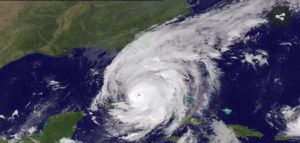
This satellite image from the National Oceanic and Atmospheric Atmospheric Administration shows Hurricane Irma obscuring most of Florida in 2017. Even in a particularly active year, not many hurricanes actually develop. (Photo credit: NOAA)
We are about five weeks away from the climatological peak of the hurricane season, which stretches from early June to November.
During that period, even in a particularly active year, not many hurricanes actually develop. Forming over tropical oceans ensures that warm sea-surface temperature (SST) provides a mature hurricane with a means to warm and moisten the air that flows toward the important eye-wall convection. Thus, it is not surprising that hurricanes struggle to develop if the SST is not 79.7 degrees or warmer.
Tropical cyclones also require environments in which the wind speed and direction changes very little with increasing height, or where the vertical wind shear is small.
Certain vast stretches of the tropical ocean have SSTs above the threshold value of 79.7 degrees and thus qualify as locations where the development of tropical cyclones is favored. However, within such areas, it is only when the vertical shear is very low — from the surface to about 8 miles above the surface — that hurricanes can form and grow to maturity. In a given location in the tropics, it is much more likely that the shear condition, not the SST, will vary from one day to the next.
There are a number of physical factors that can conspire to render the vertical shear too extreme to allow for hurricane development. One such factor is the presence of the so-called subtropical jet stream, which is located between 20 degrees and 30 degrees latitude and about 8 miles above the ground in both hemispheres.
The subtropical jet stream is an ever-present feature of the general circulation of the tropics and has wind speeds routinely in excess of 130 mph. Such strong winds well above the surface are more than sufficient to provide a toxic amount of vertical shear to a nascent tropical cyclone. The small number of hurricanes every year testifies to the hostility of the environment to their development.

